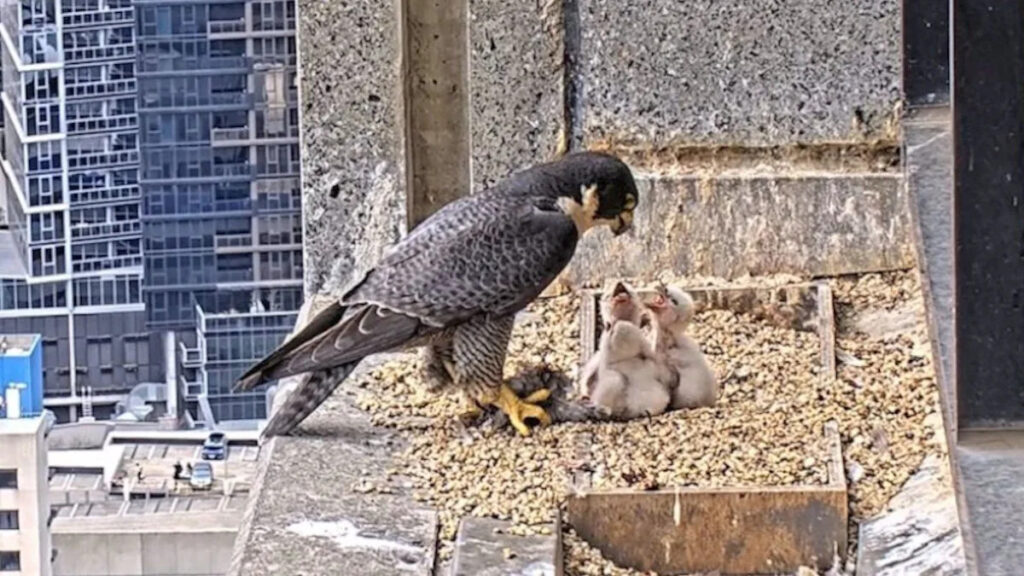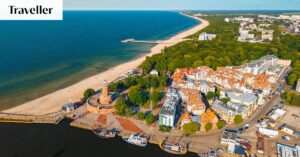
Since the end of August, tens of thousands of Australians have been captivated by “Nestflix,” a 24-hour livestream featuring the dramatic lives of peregrine falcons nesting atop a Melbourne skyscraper. This unique reality channel, which gained popularity during the COVID-19 pandemic, showcases high-stakes avian drama, including airborne battles, family dynamics, and the breathtaking first flights of newly hatched chicks.
Currently, viewers are eagerly anticipating the moment when this year’s chicks, which began hatching at the end of September, will take their first flight. The young falcons can be seen energetically flapping their wings on the ledge—34 stories high—while their mother swoops by with pigeons in her talons. “She’s teasing the chicks, going ‘You wanna eat? Well you gotta fly,'” explains Dr. Victor Hurley, founder of the Victorian Peregrine Project.
The Launch of ‘Nestflix’
Dr. Hurley first discovered the peregrine nesting site at 367 Collins Street in 1991, the year he established the Victorian Peregrine Project, a volunteer group dedicated to the species’ preservation. Initially, the falcons struggled to successfully hatch their eggs due to the unsuitable nesting conditions in a metal gutter. Dr. Hurley advised the building managers to install a nest box, leading to the successful hatching of three chicks the following year.
In 1993, a CCTV camera was installed to monitor the nest, and Dr. Hurley would set up a large screen in the building’s foyer for public viewing during breeding season. The livestream went online in 2017, and “Nestflix” was born, attracting a dedicated following on YouTube and a Facebook fan page with over 50,000 members.
“It’s quite a supportive corner of the internet where people just enjoy watching birds,” says Kylie Humrick, a group moderator who joined in 2017. “During COVID, the group just exploded because it gave people a sense of connection to the world around them.”
Fights and ‘Floaters’
The prime nesting site has hosted several pairs of falcons over the years, with its central Melbourne location offering a reliable food supply. Peregrine falcons are highly territorial, and the site has witnessed intense battles with “floaters”—unpaired peregrines attempting to claim the territory.
In 2022, a dramatic change occurred when a male falcon was replaced by a younger rival during the incubation period. “The older male was almost certainly killed by the step-father,” Dr. Hurley notes, adding that the new male was inexperienced but eventually provided for the chicks.
In 2023, the resident female falcon appeared to suffer brain damage after a confrontation with another female, leading to a failed breeding season. “These things kill other birds for a living, that’s their specialty,” Dr. Hurley states, emphasizing the natural behavior of these predators.
The Future of the Falcons
Peregrine falcons, once nearly wiped out in Australia due to pesticide use, have rebounded since the 1980s when harmful chemicals were banned. They are now found in major cities across the country, where skyscrapers mimic their natural cliffside habitats.
The first flight is a critical milestone for the chicks at 367 Collins Street, expected any day now. The male chick is likely to fly first, followed by his sisters. Female chicks, being heavier, take longer to develop the necessary strength to fly. Dr. Hurley hopes they will take their time, as rushing could lead to accidents.
“A 60% mortality rate in the first year means it’s a tough gig being a young peregrine falcon,” Dr. Hurley observes, noting that such rates are common among predators.
Excitement is building among the Facebook group members as the fledging approaches. “It’s always an exciting time in the group, viewership definitely goes up the closer we get to fledging,” says Ms. Humrick. “We don’t know what happens to them after they fledge, but it’s nice to see them reach that milestone.”






